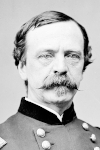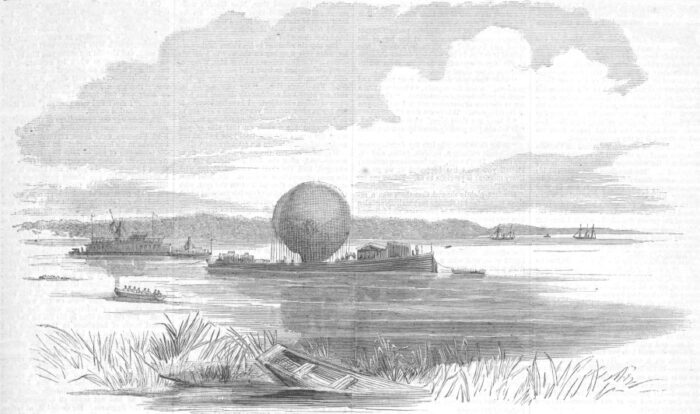
Last week, we looked at Thaddeus S. C. Lowe’s need for help from the Washington Navy Yard mechanics to make his balloons a going concern. There was one problem with their solution, however: It was heavy. The boxes required to create hydrogen gas to fill the balloons had to be structurally sound on the outside to survive the internal pressure, and had to be lined with heavy copper sheathing within to keep the sulfuric acid contained. Not to mention the weight of the acid and iron needed in the production as well.
Carting this around was not easy, and the thought was that it would be easier to do by water. This made sense especially in that the Potomac river was close to a lot of the fighting in southern Virginia. Once again, it was time to go to the Navy Yard.
Here, a coal barge named USS George Washington Parke Custis, which had been bought by the Navy in August of 1861, was retrofitted with Lowe’s balloon gas generators and otherwise modified for use by the aeronaut– mainly by making the deck one large flat surface, on which the gas generators could be mounted.
On November 10, the work was ready. Two days later, Lowe wrote a description of the expedition down the Potomac:
I have the pleasure of reporting the complete success of the first balloon expedition by water ever attempted. I left the navy-yard early Sunday morning, the 10th instant, with a lighter (formerly the G. W. P. Custis) towed out by the steamer Coeur de Lion, having on board competent assistant aeronauts, together with my new gas generating apparatus, which, though used for the first time, worked admirably. We located at the mouth of Mattawoman Creek, about three miles from the opposite or Virginia shore. Yesterday I proceeded to make observations, accompanied in my ascensions by General Sickles [That’s him, above] and others. We had a fine view of the enemy’s camp-fires during the evening, and saw the rebels constructing new batteries at Freestone Point. I was under the necessity of returning for some necessary articles this morning, and will go back immediately to continue in person the reconnaissances.

After making all necessary arrangements below, and leaving a competent aeronaut and assistants in charge, I shall return and place the other balloons wherever the general desires them. I have now a competent aeronaut for each of the new balloons, and in the course of a few days they can all be in active operation. I will call and see you on my return.
The success led to the request that the Custis be moved down to Fort Monroe, a Union fort guarding the entrance to the Hampton Roads area. As the lone outpost otherwise surrounded by Confederate-held territory, knowing what was going on in the area was crucial. In this case, the steamer Hugh Jenkins, which had been bought in Baltimore the previous year, was used to transport the balloon.
While the balloons continued to be used for a while, Lowe contracted malaria in June 1863, by the time he recovered, his equipment was scattered. While he made some efforts to assist again, by August of that year, the balloon corps was no more.
